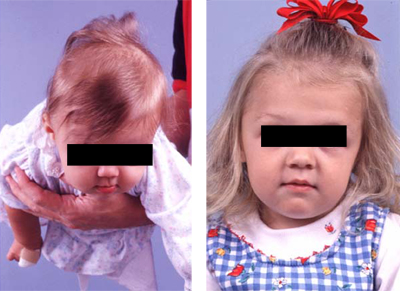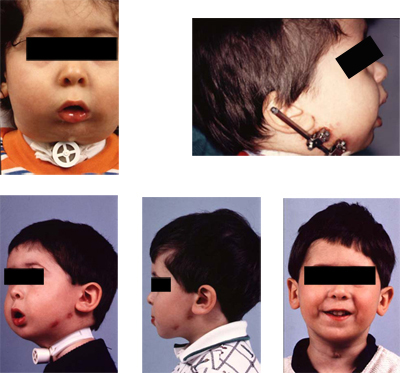Craniofacial Anomalies
Craniosynostosis
Before a child is born, the bones of the skull are not fused; this allows the bony
plates of the skull to be more flexible, so the head can be molded during birth. Otherwise,
it would be very difficult for a child's head to pass through the birth canal. Craniosynostosis
is a condition that occurs when the bone junctions, or sutures, fuse prematurely.
When some of the skull bones fuse in the womb, it can affect the baby's head shape.
Sometimes the growth of the brain can also be influenced, and will benefit from surgical
release of the constricted bones. Some examples follow.
Plagiocephaly (plagio=oblique + cephaly=head)

This condition presents with a lop-sided or twisted appearance to the head, with one
side of the forehead or posterior head pushing out farther than the other. It can
be associated with premature closure of one or both of the coronal or lambdoid sutures,
or may come as a result of pressure of the mother's pelvic bones on the skull (positional
plagiocephaly.)
Scaphocephaly (scapho=boat, skiff + cephaly=head)
Also known as dolichocephaly (dolicho=long + cephaly=head.) In this case, the head
has a long, narrow shape. Scaphocephaly usually results from premature closure of
the sagittal suture (sagittal synostosis.) It may require surgical correction depending
upon its severity.
Brachycephaly (brachy=short + cephaly=head)
This condition is characterized by a head that is wide, with a shortened anterior
posterior length. It can occur with bilateral synostosis of the coronal or lambdoid
sutures, and is associated with some syndromes. In more severe cases, the skull may
grow taller beyond the closed sutures, resulting in a cone-shaped or towering skull
(turribrachycephaly.) This generally requires surgical release and correction.
Other Other Craniofacial Conditions
Hemifacial Microsomia
A condition in which one half of the face does not grow as much as the other, often
presenting with smaller features on the affected side, and sometimes a missing or
partially missing ear (anotia, microtia.) Usually surgery is required to reconstruct
the ear and to balance the growth of the jaw on the affected side.
Pierre Robin Sequence

In this genetic sequence, during development the chin does not come away from the baby's chest as completely as it should during the development of the oral cavity and associated structures, and the result is a combination of characteristics including a small, pushed back lower jaw, a large tongue, and often a wide, U-shaped cleft of the hard and soft palate. Sometimes the problem also affects the growth of the trachea and soft tissues of the pharynx, and the baby's airway can be severely decreased in size or development. Because of the small jaw and large tongue, the airway may become obstructed. Some of these children require tracheostomies or other surgical interventions to increase the airway size.